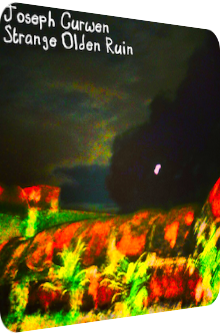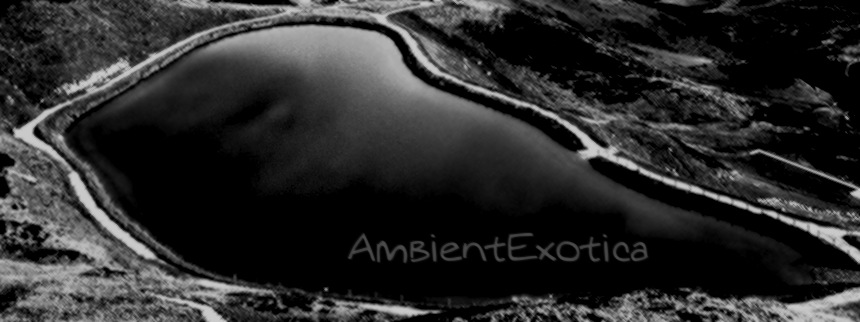
Joseph Curwen
Strange Olden Ruin
2013
When I was a student, I often played Dark Ambient music while reading Gothic fiction that I needed to prepare for class. Music and prosaic fiction formed a symbiosis, a strong bond of alatoric compatibility, for even though the creators of these works were oftentimes divided – both by centuries and art forms – and the music was never created to go along with the text in the first place, I enjoyed the augmentation or even amplification of a horror novel when the right music underlined the respective scenery. Enter Briton Joseph Curwen from Newcastle-upon-Tyne who has the exactly right music for the respective occasion, at least when it comes to the prolific author H. P. Lovecraft (1890–1937) and his alienating works which unite otherworldly incidents with outer worlds and tales of horror with poignant observations of mankind’s behavior in stress situations. I consider myself quite a fan of Lovecraft's creativeness, and there is no doubt that Joseph Curwen is an even more devoted follower of Lovecraft’s complete works (if only for the fact that Joseph Curwen is a persona from the Lovecraft story The Case Of Charles Dexter Ward), and so he transmutates their enigmatic energies and moulds them into his music, though this is not perfectly correct: he rather sets a specific text to music.
In terms of Strange Olden Ruin, self-released in June 2013 and available to purchase (name your price) and listen to in full at Bandcamp, the British artist draws the listener’s attention to Lovecraft’s short story The Moon-Bog, written around 1921 and published in 1926. Set in rural Ireland, it is about a new owner of a castle who wants to drain a peculiar swamp in front of his abode, as a legend implies hidden secrets and riches in it. Naturally, some force begs to differ, and the villagers are largely unwilling to proceed. Strange Olden Ruin contains Three tracks ranging from 22 to bestial 36 minutes of daedal Dark Ambient structures of the Drone kind. Curwen, however, is no fanatic nerd, by no means at all! He himself describes his music as “based on that eery bit between life and death the day after a big party,” and disagreeing with this insightful remark would be useless. My in-depth review is based on guesswork, since Curwen does not tell which instruments are used, but rest assured that he captures the essence of Lovecraft’s work and, in this particular case, The Moon-Bog which is roundabout 15 times shorter than the megalomaniac dimensions of Strange Olden Ruin.
Dancing Lights In The Dark Of The Moon is the first (super)natural phenomenon that Curwen distills from Lovecraft’s short story and transforms into a frighteningly murky and bleak Drone creepiness. The whitewashed tape hiss rivers that greet the listener soon cross-fade into a slowly increasing dissonance of Gothic legato organ washes whose wave-like undulation emanates a cavalcade of malevolent colors, depending on the current state. Even when the implied forsaken ferocity that is the organ is almost inaudible, its sanguine complexion and liaison remain intact, waiting for the next wave to float over the listening subject. Spectrally frizzling drones accentuate the pitch-black nullity, in-between the cusps of each new billow a distantly brazen stream is in fluxion, reminiscent of a filtered electric guitar, but far too subtle to find itself exposed by any clumsy reviewer that comes along. Despite the loop-like and orderly nature of the organ drones, they are actually not based on repetitive heterodynes, but change their threatening timbre and color time and again, oftentimes resembling metallic harshness, followed by a much more insidious miasmatic warmth in other instances. During all these moments, an abyssal-acroamatic aorta of bass runlets meanders through the toxic torment. Good speakers or headphones allow this depth to unfold and let this first tune appear much more hollow and wider. These are not just some stupid low frequencies that are only added to give this arrangement more oomph. I would go so far as to call them essential, for their plasticity and spaciousness create a much more cavernous architecture. The fear factor of Dancing Lights In The Dark Of The Moon is comparably mild-mannered, only looming, never breaking out of the draped veils of darkness in order to overcome the figurative bystander. But this is just the beginning anyway…
“All digital noise intended” says the warning that graces Joseph Curwen’s Bandcamp page for this work, and here in the second, almost 30 minutes long Drone critter, it is applicable, if not right from the get-go. Chill Winds When The Night Was Warm is the title, and the revved up bane is immediately noticeable. The titular chill winds are heavily reverberated and seem like hefty exhalations of a brutish behemoth. This is only one part of the slow yet tense movement, the other being the strangely luminescent guitar streams whose feigned friendliness should not be taken seriously. Digital artifacts soon appear; like overdriven blisters or threshold-crossing figments, they cause the scratching jitters that are so ubiquitous and well-known to the loving generation of overmodulated digital music. While the structure of this second track is similar to the first one, the impetus and aforementioned tension are expanded… and so is the concept of nonentity aka silence. Regardless of whether the eponymous winds are blowing or the crystalline-fragile traces of monotonous quasi-melodies are whirling, their force is doubled. And this concept of doubling also revolves around the polyphony that is applied to the drone structures, making it harder to pinpoint the intended mood. Since there is no faux-organ involved in this tune, there are less rotten scents of warmth and more hissing gusts in here than before.
Wraiths In White Hovering Over The Waters is the gruesome conclusion of 36 minutes. The internal structuring process differs strikingly from the previous two installations. While still residing in doomed Drone spheres, the insistence on the wave formula is lessened. There is of course a certain reliance on waves, or else the composition would become an adamantly straightened Shoegaze anthem, but the perceived height of their aural appearance is diminished. Beyond the gunmetal-colored steel nuclei of the gale-underpinned fog banks, there is an orchestra string-resembling depth that shimmers frighteningly, even coming to the forefront when the levels of hiss wane for a short moment. The slowly wandering tone structures are transparently simmering. This lucent physiognomy is surprisingly effective in transporting horror and blight: the two tones or so are cleverly chosen and encapsulate the pure evil in their dry form. No hall effect or echo desiccates the terrifying sinews. Notwithstanding the relative gentleness, easygoing appearance and lack of any shocking protuebrance or explosion, the archaic melody crawls into the skin, destroys the good mood or self-esteem and is further driven into the cracks between the cells by the reigning winds. If there is one disadvantage to be mentioned, it has to be the overly long runtime. There is not enough change or progression, only a crestfallen dungeon of despair that seems to be maintained ad infinitum.
Strange Olden Ruin is a representative in-depth review of Joseph Curwen’s work aesthetics and ethics. His output is too voluminous and rapid for me to follow each work with the same care and devotion, an approach he shares with like-minded Dark Ambient aficionado Willy Stamati (whose polymorphous and sample-underlined I Will Dig You Up has been reviewed for the same reason). Regardless of my personal time constraints, Strange Olden Ruin can serve as a blueprint for pinpointing the producer’s style. Curwen’s Drone structures are essentially minimalistic, oftentimes stripped to the bones, with only a few half-tones serving as nearly untraceable melodies. These cryptic wastelands are then amplified. Storms are raging, the respective color of a surface or pattern gets saturated, distant guitars are placed a bit closer to the forefront in the mix. The sheer length of his arrangements can be applauded, as they not only allow a listener to deeply sink in, but to keep in sync with H. G. Lovecraft’s respective short story or novella. This is the strongest case to make: Curwen’s artistic vision truly unites with the endlessly labyrinthine decay of Lovecraft’s prose. Both works, while not perfectly in sync, form a persuasive symbiosis. That the producer from Newcastle-upon-Tyne willfully and exclusively attaches his Ambient visions to Lovecraft – at least before and around the publishing date of this review – and does not yet use his skills to come up with albums that can stand on their own feet is a phenomenon that will likely experience a course correction sometime, given the heavy release cycles and the limited amount of artifacts in Lovecraft’s oeuvre. Fans of H. P. Lovecraft will naturally get the most out of Joseph Curwen’s frightening sound sculptures, and so do Dark Ambient fans who are in favor of Drone structures.
Further listening and reading:
- You can purchase (name your price) and listen to Joseph Curwen’s Strange Olden Ruin in full at Bandcamp.
- Follow Joseph Curwen at Twitter: @Curwendrone.
Ambient Review 238: Joseph Curwen – Strange Olden Ruin (2013). Originally published on Jul. 10, 2013 at AmbientExotica.com.
